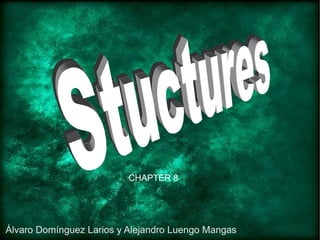
La tenknolojiaaah!!!!!c
- 1. CHAPTER 8 Álvaro Domínguez Larios y Alejandro Luengo Mangas Stuctures
- 2. 8.1 Types of structures 1 Frame structures 2 Shell structures 3 Arch 4 Mix and match 5 Mass structures 6 Suspension structures 8.2 Structural elements 8.3 Types of unions 1 Permanent unions 2 Non-permanent unions 8.4 Forces on structural elements 1 Tensional strain 2 Compression forces 3 Shear strain 4 Torsion forces 5 Bending forces
- 3. What's a structures? A structure is a group of elemnts united to support a load with stability Everything has a structure, otherwise it would collapse under any forces Ex. humans have skeleton, houses have columns, beams and a roof
- 4. 8.1 Types of Structures Frame Structures The frame structure is the most common choice of structure . These structures are composed of long elements (bars,tubes...) joined to each other at the ends. The elements of each are made of strong materials ·Advanteges of frame structures: they are relatively easy t6o desing and build in expensive manufacture lightweight and don't require much material ·Disadvanteges: they aren't good for very big loads or strong impacts
- 5. Element Union Load
- 6. Shell structures Shell structures are made of a thin outer layer of material that surround a volume. That volume can be empty space or can be filled with something that has no structural relevance. They are like a strong and hard coat maintains required shape. Shell structure can be: · Natural (EX: egg, shellfish) · Artificial (EX. Bottles, ballons) So this mstructures keeps their shape and support the loads without a frame or solid mass material inside The outer layer that makes the shell can be thin because the forces are spread throughout the whole structure, dissipainting the load all over the shell .
- 7. Arch Romans invented the arch. There are many types , but the semicircular arch,which was the Roman arch ,still remains the most used. It were made of stone .The stone at the very top is called the”keystone” Its own weight is the main load and the geometry of the arch displaces the forces to the side, so that a large free space is left under the arch. This makes it suitable for bridge since the large space left underneatcan span a river, stream, or other obstacle.
- 8. Mass Structures They are simply made 9of clump material, filling the body completely. They are made of low-quality materials, but the structures is normally thick. ·Examples of Mass estructures are: Mountains and coral reefs. ·Examples of man-made mass structures are: sandcastles, dams... ·Advanteges: held in place by its own weight ·Disadvanteges: heavy; need much materials; and occupy large amounts of space.
- 10. Suspension structures A suspension structure holds an element (often a beam) by cables that are held from the top of a tall clumn. The space (distance) between one column and the next is called the “span”. This type of structure has the longest span of all structures. Because of this,suspension structures are often best for bridges that need to cover bid rivers or even small portions of the sea. ·Advanteges: good for covering a very large span. · Disadvanteges: expensive to build
- 12. 8.2 Structural Element An elemen can be defined as “ the simplespart of the whole” In a strucuture the forces of every elements are calculated and the element ( i.e. Beam or column) is designed to withstand them.
- 14. 8.3 Types of unions The structural elements must be united. · Permanent Unions The are meant for structures that will not need to be desassembled. · Non-Permanent Unions Non-permanets Unions are those designed assebled and disassembled the elments of the strucuture as many times as necessary
- 15. 8.4 Forces on structural elements A successful must be able to withstand all the forces that it will experience without topping over or collapsing
- 16. Is the strain that causes an element to stretch. It can be due to forces that pull an element from its ends . Tensional Stains:
- 17. Compression forces: They are those forces that cause an element to get squeezed or buckled.
- 18. Shear strain: Shear forces act across a material in such a way that they can force one part of an element to slide over another.
- 20. Bending Force: Bending act at an angle to a member (at 90º an the axes line in the drawing) making it bend.
- 22. Torsion forces: If you apply a turning force at one end of an element and; if the element is fixed to a support at the other end, the element twists.
- 23. Fin